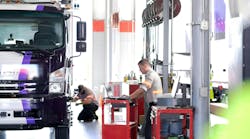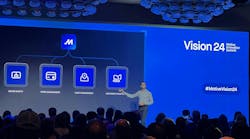In a mystery novel, the most important events often take place on the perimeter of the story, in plain sight of anyone who cares to notice, but not in the thick of the noisy and fast-paced action that captures and rivets reader attention. The saga of the 2002 diesel engines and the little-noted development of fuel cell technology are beginning to seem like just such a complex cliffhanger.
As tensions mount over diesel engine performance and cost unknowns, fuel cell developers are quietly moving ahead with what some observers believe will be the power source of the future. If this is true, it may turn out to be the most important transportation industry event since trucks replaced horse-drawn wagons, and a surprising last chapter in the engine technology story that has held many of us in suspense for months.
This June, for example, DaimlerChrysler's “NECAR 5” became the first fuel cell-powered car to complete a cross-country trip of the U. S. The history-making little coupe completed its San Francisco to Washington, DC, run in just 16 days. The methanol that provided hydrogen for the fuel cell was delivered in advance to different points along the 3,000-mi. route to permit refueling every 300 mi. “Our goal was to make it to Washington to deliver the message that fuel cell technology is rapidly advancing,” explained Dr. Ferdinand Panik, head of DaimlerChrysler's fuel cell project group.
Less than two weeks later, another vehicle, this one powered by a zinc fuel cell designed to be refueled on the road, completed its own 100-mile demonstration test drive in California. According to the developer, Metallic Power of Chula Vista, CA, the test was especially significant because the company completed the entire development-to-test cycle in only three years and with total company-wide funding of less than $30 million.
“Hydrogen fuel cells will be important, and they are a little farther along in their development cycle than zinc fuel cells,” observes Susan Connell, spokesperson for Metallic Power, “but we believe zinc fuel cells have some advantages. You don't have to carry hydrogen gas onboard, there are no high-pressure or high-temperature operating requirements and zinc fuel cells weigh less than half what a typical lead acid battery weighs, plus they can be easily refueled.”
Metallic Power's zinc fuel cells are fueled with small zinc pellets. As the zinc is consumed inside the fuel cell, it is combined with oxygen from the air to form zinc oxide. The zinc oxide (and spent electrolyte) can be completely regenerated back into fresh fuel, notes Connell, so nothing is wasted.
According to some industry analysts, Honda may be the first automaker to actually bring fuel cell-powered vehicles to the market. In September of 1999, the company unveiled two fuel cell-powered electric vehicles and announced plans to offer commercial versions by 2003. Honda's prototypes use fuel cells that generate electrical energy through the chemical reaction of oxygen and hydrogen. In this case, the exhaust product is water.
For the trucking industry, fuel cells will almost certainly be used to power auxiliary devices before they are used to drive the vehicle. Metallic Power expects to have such products ready for the transportation and marine markets in three years and other manufacturers are planning launch dates even sooner.
With the events in the Middle East and South America putting American access to oil in constant jeopardy, however, fuel cell technology could become a vitally important power source for the transportation industry almost overnight. It would be a surprise ending indeed to the 2002 engine story, or would it?


